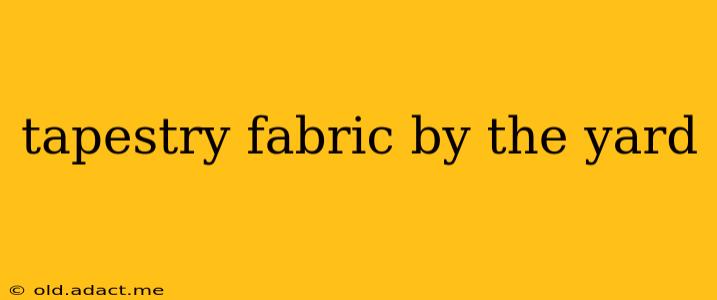Tapestry fabric, with its rich history and stunning visual depth, offers a unique and luxurious option for a variety of projects. From upholstery and wall hangings to clothing and accessories, the possibilities are as varied as the designs themselves. But choosing the right tapestry fabric by the yard requires understanding its characteristics, types, and care. This comprehensive guide will equip you with the knowledge to make informed decisions and successfully incorporate this captivating textile into your creations.
What is Tapestry Fabric?
Tapestry fabric is a type of heavy, woven textile characterized by its intricate designs and rich textures. Unlike printed fabrics, tapestry designs are created through a process of weaving different colored threads together, creating a three-dimensional effect. This complex weaving technique, often employing a high thread count, results in a durable and visually stunning fabric with a unique hand. The term "tapestry" itself often evokes images of large, elaborate wall hangings, but the fabric itself can be used in a much wider range of applications.
What are the Different Types of Tapestry Fabric?
Several factors differentiate tapestry fabrics. Understanding these nuances is crucial for selecting the appropriate fabric for your project.
Fiber Content:
Tapestry fabrics can be made from various fibers, each with its own properties:
- Wool: Traditional and popular, wool tapestries offer warmth, durability, and a luxurious feel. However, they can be more expensive and require careful cleaning.
- Cotton: Cotton tapestry is more affordable and easier to care for than wool, making it a good choice for less demanding projects. However, it may lack the same warmth and luxurious feel.
- Silk: Silk tapestries are exceptionally luxurious, with a beautiful sheen and drape. They are, however, delicate and require specialized cleaning.
- Synthetic Fibers: Blends incorporating synthetic fibers like acrylic or nylon offer increased durability and affordability, often mimicking the look and feel of wool at a lower cost.
Weave Structure:
The weave structure also influences the final appearance and feel of the fabric:
- High-Thread Count: A higher thread count results in a denser, more durable, and smoother fabric.
- Loose Weave: A looser weave may be more breathable but less durable.
Design and Pattern:
Tapestry fabric designs range from classic, intricate patterns to modern, abstract designs. Consider the overall aesthetic you're aiming for when choosing a fabric.
Where Can I Buy Tapestry Fabric by the Yard?
You can find tapestry fabric by the yard from various sources:
- Online Retailers: Many online fabric stores offer a wide selection of tapestry fabrics, often with detailed descriptions and images.
- Local Fabric Stores: Check your local fabric stores for in-person browsing and expert advice.
- Specialty Shops: Some shops specialize in high-end or antique tapestry fabrics.
How Much Does Tapestry Fabric Cost Per Yard?
The cost of tapestry fabric varies significantly depending on the fiber content, weave structure, design, and supplier. Expect prices to range from moderately priced to quite expensive, especially for high-quality wool or silk tapestries.
How to Care for Tapestry Fabric?
Proper care is crucial to maintaining the beauty and longevity of your tapestry fabric. Always follow the manufacturer's care instructions, but generally:
- Dry Cleaning: Many tapestry fabrics, especially those made from wool or silk, should be dry-cleaned.
- Hand Washing: Some cotton blends may be hand-washable, but always test a small, inconspicuous area first.
- Avoid Harsh Chemicals: Never use harsh detergents or bleach.
- Gentle Pressing: If ironing is necessary, use a low setting and a pressing cloth to protect the fabric.
What Projects Can I Use Tapestry Fabric For?
The versatility of tapestry fabric allows for a wide range of projects:
- Upholstery: Create stunning upholstery for chairs, sofas, or ottomans.
- Wall Hangings: Tapestry fabric is ideal for creating beautiful and unique wall art.
- Clothing: Use it for making jackets, skirts, or dresses for a luxurious, textured look.
- Accessories: Create bags, scarves, or cushions with striking designs.
- Home Decor: Use it for curtains, throws, or other decorative accents.
Is tapestry fabric easy to sew?
Sewing with tapestry fabric can be challenging due to its weight and potential for fraying. Using sharp needles, appropriate thread, and taking your time will yield the best results. A walking foot on a sewing machine can be helpful.
What is the difference between tapestry and brocade?
While both are woven fabrics with intricate patterns, tapestry features a completely interwoven design, creating a three-dimensional effect, while brocade uses supplementary weft threads to create raised patterns on the surface.
This guide should give you a good foundation in choosing and using tapestry fabric. Remember that the beauty of tapestry lies in its unique characteristics, and selecting the right fabric for your project is key to showcasing its full potential. Happy weaving!
